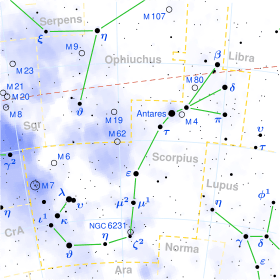Theta Scorpii
 θ (circled) in the constellation Scorpius. | |
| Observation data Epoch J2000 Equinox J2000 | |
|---|---|
| Constellation | Scorpius |
| Right ascension | 17h 37m 19.12985s[1] |
| Declination | –42° 59′ 52.1808″[1] |
| Apparent magnitude (V) | 1.84 (1.862 + 6.22)[2] |
| Characteristics | |
| Spectral type | F0 II[3] |
| U−B color index | +0.21[4] |
| B−V color index | +0.40[4] |
| Astrometry | |
| Radial velocity (Rv) | +1.4[5] km/s |
| Proper motion (μ) | RA: +5.54[1] mas/yr Dec.: –3.12[1] mas/yr |
| Parallax (π) | 10.86 ± 1.49[1] mas |
| Distance | approx. 300 ly (approx. 90 pc) |
| Details | |
| Mass | 5.66 ± 0.65[6] M☉ |
| Radius | 26[7] R☉ |
| Luminosity | 1,834[6] L☉ |
| Surface gravity (log g) | 2.4 ± 0.2[8] cgs |
| Temperature | 7,268[6] K |
| Rotational velocity (v sin i) | 125[9] km/s |
| Other designations | |
Theta Scorpii (θ Scorpii, abbreviated Theta Sco, θ Sco), also named Sargas,[11] is a binary star in the southern zodiac constellation of Scorpius. The apparent visual magnitude of this star is +1.87,[4] making it readily visible to the naked eye and one of the brightest stars in the night sky. It is sufficiently near that the distance can be measured directly using the parallax technique, which yields an estimate of roughly 300 light years (90 parsecs) from the Sun.[1]
Nomenclature
θ Scorpii (Latinised to Theta Scorpii) is the system's Bayer designation.
It bore the traditional name Sargas, of Sumerian origin.[12] In 2016, the International Astronomical Union organized a Working Group on Star Names (WGSN)[13] to catalogue and standardize proper names for stars. The WGSN approved the name Sargas for this star on 21 August 2016 and it is now so entered in the IAU Catalog of Star Names.[11]
In Chinese astronomy, it is referred to as 尾宿五 (Wěisuwǔ), the Fifth Star of the Tail.
Properties
The primary is an evolved bright giant star with a stellar classification of F0 II.[3] With a mass 5.7 times that of the Sun, it has expanded to about 26[7] times the Sun's radius. It is radiating 1,834[6] times as much luminosity as the Sun from its outer envelope at an effective temperature of 7,268,[6] giving it the yellow-white hued glow of an F-type star. This star is rotating rapidly, giving it an oblate shape with an equatorial radius 19% larger than the polar radius.[9]
The magnitude 5.36 companion is at an angular separation of 6.470 arcseconds.[14]
Modern legacy
Sargas appears on the flag of Brazil, symbolising the state of Alagoas.[15]
References
- 1 2 3 4 5 6 van Leeuwen, F. (November 2007). "Validation of the new Hipparcos reduction". Astronomy and Astrophysics. 474 (2): 653–664. arXiv:0708.1752
 . Bibcode:2007A&A...474..653V. doi:10.1051/0004-6361:20078357.
. Bibcode:2007A&A...474..653V. doi:10.1051/0004-6361:20078357. - ↑ Høg, E.; Fabricius, C.; Makarov, V. V.; Urban, S.; Corbin, T.; Wycoff, G.; Bastian, U.; Schwekendiek, P.; Wicenec, A. (2000). "The Tycho-2 catalogue of the 2.5 million brightest stars". Astronomy and Astrophysics. 355: L27. Bibcode:2000A&A...355L..27H.
- 1 2 Houk, Nancy (1978), "Michigan catalogue of two-dimensional spectral types for the HD stars", Ann Arbor : Dept. of Astronomy, Ann Arbor: Dept. of Astronomy, University of Michigan, 2, Bibcode:1978mcts.book.....H
- 1 2 3 Johnson, H. L.; et al. (1966), "UBVRIJKL photometry of the bright stars", Communications of the Lunar and Planetary Laboratory, 4 (99): 99, Bibcode:1966CoLPL...4...99J
- ↑ Wilson, R. E. (1953). General Catalogue of Stellar Radial Velocities. Carnegie Institute of Washington D.C. Bibcode:1953GCRV..C......0W.
- 1 2 3 4 5 Hohle, M. M.; Neuhäuser, R.; Schutz, B. F. (April 2010), "Masses and luminosities of O- and B-type stars and red supergiants", Astronomische Nachrichten, 331 (4): 349, arXiv:1003.2335
 , Bibcode:2010AN....331..349H, doi:10.1002/asna.200911355
, Bibcode:2010AN....331..349H, doi:10.1002/asna.200911355 - 1 2 Pasinetti-Fracassini, L. E.; et al. (February 2001) [December 2000 (arXiv)], "Catalogue of Stellar Diameters (CADARS)", Astronomy and Astrophysics, 367 (2): 521–524, arXiv:astro-ph/0012289
 , Bibcode:2001A&A...367..521P, doi:10.1051/0004-6361:20000451
, Bibcode:2001A&A...367..521P, doi:10.1051/0004-6361:20000451 - ↑ Samedov, Z. A. (1988), "Investigation of the atmospheres of the stars ι1 Sco (F2 Ia) and θ Sco (F1 II)", Astrophysics, 28 (3): 335–341, Bibcode:1988Ap.....28..335S, doi:10.1007/BF01112969
- 1 2 van Belle, Gerard T. (March 2012), "Interferometric observations of rapidly rotating stars", The Astronomy and Astrophysics Review, 20 (1): 51, arXiv:1204.2572
 , Bibcode:2012A&ARv..20...51V, doi:10.1007/s00159-012-0051-2.
, Bibcode:2012A&ARv..20...51V, doi:10.1007/s00159-012-0051-2. - ↑ "tet Sco -- Variable Star", SIMBAD Astronomical Object Database, Centre de Données astronomiques de Strasbourg, retrieved 2012-02-18
- 1 2 "IAU Catalog of Star Names". Retrieved 28 July 2016.
- ↑ Burnham, Robert (1978), Burnham's celestial handbook: an observer's guide to the universe beyond the solar system, Dover books explaining science, 3 (2nd ed.), Courier Dover Publications, p. 1676, ISBN 0-486-23673-0
- ↑ IAU Working Group on Star Names (WGSN), International Astronomical Union, retrieved 22 May 2016.
- ↑ Eggleton, P. P.; Tokovinin, A. A. (September 2008). "A catalogue of multiplicity among bright stellar systems". Monthly Notices of the Royal Astronomical Society. 389 (2): 869–879. arXiv:0806.2878
 . Bibcode:2008MNRAS.389..869E. doi:10.1111/j.1365-2966.2008.13596.x.
. Bibcode:2008MNRAS.389..869E. doi:10.1111/j.1365-2966.2008.13596.x. - ↑ "Astronomy of the Brazilian Flag". FOTW Flags Of The World website.